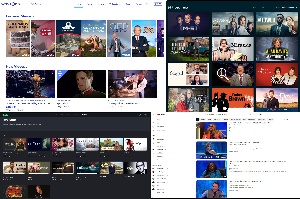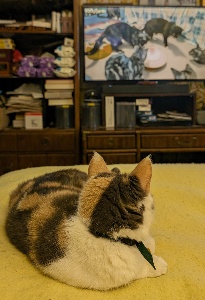Listen to the Podcast
23 Feb 2024 - Podcast #870 - (16:02)
It's Like NPR on the Web
If you find the information TechByter Worldwide provides useful or interesting, please consider a contribution.

If you find the information TechByter Worldwide provides useful or interesting, please consider a contribution.
I’ve pondered that a time or two since we dropped cable and switched to a variety of streaming services about three years ago. Our primary goal then was to reduce the cost of watching television. The switch saved more than $600 per year.
Initially I wrote about switching in August 2021, with a follow-up a little less than a year later in June 2022. At the beginning, the cost was around $160 per month, compared to nearly $220 for cable. Since then, most of the streaming services have increased their prices and we’ve added a couple of extra services. Even though I watch far less television than my wife does, I probably use more of the streaming services.
The cost for internet and cable television services has remained about the same, but some internet service providers have started offering a streaming option that might include many of the sources that are in various streaming services.
 The cost is now $178 per month, which reflects the addition of a couple of new services that probably aren’t used enough to justify their presence. But even though some could be eliminated and using the cable provider’s new streaming service would cover many, but not all, of the channels we watch, using the various services seems to still be the best option. For now.
The cost is now $178 per month, which reflects the addition of a couple of new services that probably aren’t used enough to justify their presence. But even though some could be eliminated and using the cable provider’s new streaming service would cover many, but not all, of the channels we watch, using the various services seems to still be the best option. For now.
If you’re considering a switch from cable to streaming or from streaming back to cable, here are some things to consider.
First, neither solution is ideal and both seem to cost a lot—at least until you stop to think about hardware, software, licensing fees, and payments to the talented people in front of and behind the cameras who make the entertainment possible.
If simplicity of use is your primary consideration, it’s cable. You get a magic box that sits near the television and comes with a remote control. You have access to all local channels and dozens or hundreds of cable channels. Unless you sign up for a video recorder service, you’ll have to watch when the program is on.
If convenience and flexibility are at the top of your list, streaming is the way to go. Sign up for the services that offer the programs you want and you can watch them anytime you want. And you can watch programs on your computer, notebook, tablet, or phone. This is an option I like.
Cable gives you live content with real-time access to news, sports, and network programs as they’re being broadcast. Depending on your budget, you can choose from a huge variety of channels. Ease of use is a plus and the cable signal usually continues to be present even if the provider’s internet functions are slow.
 Streaming complicates things a bit because you’ll need either a smart television or a plug-in device that connects the television to your home network. The big advantage is that you can watch whichever programs you want to watch whenever you want to watch them. The cost may be lower than cable, but that depends on how many streaming services you sign up for.
Streaming complicates things a bit because you’ll need either a smart television or a plug-in device that connects the television to your home network. The big advantage is that you can watch whichever programs you want to watch whenever you want to watch them. The cost may be lower than cable, but that depends on how many streaming services you sign up for.
An article by Charlie Warzel in The Atlantic highlights the problem with streaming: Too many choices and the requirement to subscribe to a service just to get the one program you really want to watch.
Warzel writes “Most evenings, I find myself stuck in this phase, during which time I am likely to cycle through something resembling the five stages of grief. There’s Denial (I swear I had a Paramount+ account); Anger (I cannot believe I have to pay for Paramount+); Bargaining (I promise I will cancel my subscription after the one-week Paramount+ trial period ends); Depression (I cannot believe I didn’t remember to cancel Paramount+ after the trial period ended); and Acceptance (Let’s just head to Netflix and watch Suits).”
 <<< Streaming makes it possible for Holly Cat to watch videos that teach her how improve her cat techniques.
<<< Streaming makes it possible for Holly Cat to watch videos that teach her how improve her cat techniques.
And I realized that he was describing the dilemma I’ve encountered, and perhaps the one you have also encountered. “Interested in Disney+? That’ll be $8 dollars a month. Unless you want it ad-free, then it’s $11 a month. How about Hulu? That’s $8 a month or $80 a year if you’re willing to put up with ads, or $15 a month without ads. But what if I told you that you could have Disney+ and Hulu together? That’ll cost you $10 a month with ads; an ad-free version will run you $20 a month. Want to add ESPN+ to the bundle? No problem; just add $3 a month. Or $10, if you don’t want those pesky commercials. Got it?”
Throughout the process I have failed to consider seriously Sling from Dish. The price is low and the ability to record programs is appealing, but there are so few channels. Sling does offer around 50 extra channels as add-ons in related groups of 5 to 10 channels. Even if you add them all, the monthly fee is still going to be lower than Fubo, for example, or most of the other “cable replacement” services such as YouTube TV, DirecTV, or Hulu + Live TV.
And then there’s Philo with more than 100 channels on offer. Low price. Just $25/month instead of four times that with Fubo. But Philo doesn’t offer any local channels or popular news channels. Maybe that’s a worthwhile consideration, but making changes entails a fair amount of work to remove an existing service and add a new one to however many televisions you have in the house.
For me, for now, I’ll just stick with what we have. But if you’re seriously considering changes, I recommend two online articles: NPR’s How to choose the streaming services that are right for you and Tom’s Guide’s The best cable TV alternatives in 2024. Happy streaming!
The addition of artificial intelligence to photo editing tools makes improving older digital photographs not just possible, but also fun. The possibilities are nearly limitless.
In 2007, I visited a direct mail vendor in Brooklyn while in town for another event. The shop was located near the Broadway Junction Station. It’s an elevated station that serves the BMT Canarsie Line and the BMT Jamaica Line as well as the IND Fulton Street Line, which is underground.
Click any small image for a full-size view. To dismiss the larger image, press ESC or tap outside the image.
 For all its problems, the New York City transit system is what keeps the city running and I have many photos taken in and around the trains and the stations. I liked one that I took in February 2007, but there were numerous problems with it. The day was gray and hazy, and the Olympus FE180 camera — although fairly robust for the time — doesn’t compare well even with today’s mobile phone cameras. The camera captured 6Mpxl images and compressed them substantially to save space. There was significant fringing and there was little detail in the highlights. The bland, overcast day muted the colors and the sky was a uniform gray.
For all its problems, the New York City transit system is what keeps the city running and I have many photos taken in and around the trains and the stations. I liked one that I took in February 2007, but there were numerous problems with it. The day was gray and hazy, and the Olympus FE180 camera — although fairly robust for the time — doesn’t compare well even with today’s mobile phone cameras. The camera captured 6Mpxl images and compressed them substantially to save space. There was significant fringing and there was little detail in the highlights. The bland, overcast day muted the colors and the sky was a uniform gray.
 So I wanted to see if improvements might be possible and started by using Upscayl, which I described on 26 Jan, to double the size of the original image and add apparent detail. Next, I imported the modified PNG image into Lightroom Classic. I used the PNG format to avoid losing any detail, which would have happened if I had selected the JPG format. I used Lightroom Classic to remove fringing and improve the image’s contrast. Then I had Lightroom Classic create a TIFF image and send it to Photoshop.
So I wanted to see if improvements might be possible and started by using Upscayl, which I described on 26 Jan, to double the size of the original image and add apparent detail. Next, I imported the modified PNG image into Lightroom Classic. I used the PNG format to avoid losing any detail, which would have happened if I had selected the JPG format. I used Lightroom Classic to remove fringing and improve the image’s contrast. Then I had Lightroom Classic create a TIFF image and send it to Photoshop.
I used Photoshop’s AI capabilities to select and replace the sky and then returned the modified TIFF to Lightroom Classic, where I added a few more tweaks, including a slight push on the image’s saturation. The result is a much more satisfying image and the process took only a few minutes. I don’t want to spend a few minutes on every old image in the Lightroom Classic catalog, but spending a few minutes on individual images can be time well spent.
 I was back in New York City in mid-June 2007 with the family as we celebrated our younger daughter’s graduation from art school. We visited a lot of art museums and I photographed Kaydee standing near the “Intersection II” sculpture by Richard Serra at the The Museum of Modern Art.
I was back in New York City in mid-June 2007 with the family as we celebrated our younger daughter’s graduation from art school. We visited a lot of art museums and I photographed Kaydee standing near the “Intersection II” sculpture by Richard Serra at the The Museum of Modern Art.
 The gigantic sculpture is amazing and I like the way Kaydee is standing, but I’ve been bugged by two aspects of the photograph every time I see it. That’s 17 years if you’re counting, and I see the image several times a year. What annoys me? The sign on the left. It’s bright white and the viewer’s eye goes there first because it’s so bright. It was a warning of some sort, so I suppose it had to be there, but it’s still annoying. And there’s a lady in the background. I had hoped for a photo in which the only person was Kaydee, but MOMA is a popular museum and waiting seemed unwise.
The gigantic sculpture is amazing and I like the way Kaydee is standing, but I’ve been bugged by two aspects of the photograph every time I see it. That’s 17 years if you’re counting, and I see the image several times a year. What annoys me? The sign on the left. It’s bright white and the viewer’s eye goes there first because it’s so bright. It was a warning of some sort, so I suppose it had to be there, but it’s still annoying. And there’s a lady in the background. I had hoped for a photo in which the only person was Kaydee, but MOMA is a popular museum and waiting seemed unwise.
Fortunately, replacing the sign was an easy task for Photoshop’s generative fill, and I even had it also replace the grate at the right of the sign. Removing the woman in the background was equally easy, although I needed two tries to get the selection right. And just like that I had an image that will no longer bug me.
Artificial intelligence can be overused and used with malicious intent, but that’s true of any tool. The hammer that can be used to build a cozy home can also be used to kill. Electricity that lights that cozy home can kill when not used carefully. AI will certainly have some negative effects, but it also offers many advantages when used properly.
“Warning: Your privacy settings can’t guarantee your privacy on Facebook.” I saw that headline on an article recently. Then I stopped, stared at it for a while, and wondered who would have any expectation of guaranteed privacy on Facebook.
Click any small image for a full-size view. To dismiss the larger image, press ESC or tap outside the image.
 I post things to Facebook every day. Cat pictures are common, as are daily “Today is ...” images. This item will be published on 23 Feb, which is National Banana Bread Day. I post these images globally and clearly have no expectation that they will be private. Occasionally I post something that only my friends can see, but I still have no expectation that what I’ve posted is private. Anyone who can see the post can share it, but Facebook will show it only to the friends that we have in common. Safe, right?
I post things to Facebook every day. Cat pictures are common, as are daily “Today is ...” images. This item will be published on 23 Feb, which is National Banana Bread Day. I post these images globally and clearly have no expectation that they will be private. Occasionally I post something that only my friends can see, but I still have no expectation that what I’ve posted is private. Anyone who can see the post can share it, but Facebook will show it only to the friends that we have in common. Safe, right?
Well, no. If I’ve posted an image, anyone who sees it can copy the photo and post it publicly. If it’s just a text comment, anyone can grab a screen shot and post it publicly.
If there’s an image or a comment that you don’t want to be available globally, the solution is surprisingly simple: Just don’t post it.
Sending the image or comment via email is no more secure, even if your email messages are encrypted. The recipient may see the comment or image as something they’d like to share with their closest 75,000 friends and anybody who uses Facebook. What you sent, thinking it was private, may show up on Facebook.
So if there’s an image or a comment that you don’t want to be available globally, the solution is surprisingly simple: Just don’t email it either.
Rick Rouse is the person who wrote the headline that stopped me in my tracks. As Rick puts it: Once you click, “Post”, “Publish”, or “Send”, that information or photograph is no longer under your control.
Don’t expect something that Facebook can’t deliver.